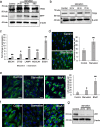Nutrient deprivation and lysosomal stress induce activation of TFEB in retinal pigment epithelial cells
- PMID: 31160892
- PMCID: PMC6537441
- DOI: 10.1186/s11658-019-0159-8
Nutrient deprivation and lysosomal stress induce activation of TFEB in retinal pigment epithelial cells
Abstract
Background: Induction of lysosomal function and autophagy is regarded as an adaptive mechanism in response to cellular stress. The transcription factor EB (TFEB) has been identified as a master regulator of lysosomal function and autophagy. TFEB is a member of the microphthalmia family of bHLH-LZ transcription factors that includes other members such as micropthalmia-associated transcription factor (MITF), TFE3, and TFEC. TFEB controls lysosome biogenesis and autophagy by upregulation of a family of genes belonging to the Coordinated Lysosomal Expression and Regulation (CLEAR) network. Here, we investigated the expression of TFEB in cells subjected to nutrient deprivation and lysosomal stress. We studied transcriptional induction of TFEB-regulated genes in response to nutrient deprivation and lysosomal stress in retinal pigment epithelial (RPE) cells. Furthermore, we also investigated the induction of autophagy and lysosomal genes upon overexpression of constitutively active form of TFEB.
Methods: Expression of TFEB and MITF protein levels were evaluated in cells subjected to prolonged periods of nutrient deprivation. mRNA levels of the CLEAR network genes was measured by quantitative real time PCR (qRT-PCR) analysis in cells deprived of nutrients, treated with ammonium chloride and upon overexpression of constitutively active TFEB. Immunostaining with LC3 antibody was used to measure autophagy flux. Labeling with lysoTracker dye was used to assess lysosomes.
Results: Our results show that nutrient deprivation increases protein levels of TFEB and MITF in ARPE-19 cells. Nutrient stress induces the expression of lysosomal (LAMP1, CTSD MCOLN1, SGSH) and autophagy (BECN1) genes. Lysosomal stress also increases the expression of lysosomal (ATP6V0A1 and LAMP1) and autophagy (p62 and BECN1) genes. Our results show that overexpression of constitutively active TFEB also induces the expression of CLEAR network genes.
Conclusions: Collectively, these observations suggest that nutrient stress induces the protein expression of both MITF and TFEB in ARPE-19 cells. TFEB-regulated transcriptional program plays an important role in adaptive response of cells during both nutrient and lysosomal stress.
Keywords: Autophagy; Lysosomal stress; Nutrient deprivation.
Conflict of interest statement
Competing interestsThe authors declare that they have no competing interests.
Figures


Similar articles
-
AMPK-dependent phosphorylation is required for transcriptional activation of TFEB and TFE3.Autophagy. 2021 Dec;17(12):3957-3975. doi: 10.1080/15548627.2021.1898748. Epub 2021 Mar 18. Autophagy. 2021. PMID: 33734022 Free PMC article.
-
The FACT complex facilitates expression of lysosomal and antioxidant genes through binding to TFEB and TFE3.Autophagy. 2022 Oct;18(10):2333-2349. doi: 10.1080/15548627.2022.2029671. Epub 2022 Mar 1. Autophagy. 2022. PMID: 35230915 Free PMC article.
-
Impaired TFEB-mediated lysosomal biogenesis promotes the development of pancreatitis in mice and is associated with human pancreatitis.Autophagy. 2019 Nov;15(11):1954-1969. doi: 10.1080/15548627.2019.1596486. Epub 2019 Mar 30. Autophagy. 2019. PMID: 30894069 Free PMC article.
-
The Transcription Factor EB Links Cellular Stress to the Immune Response .Yale J Biol Med. 2017 Jun 23;90(2):301-315. eCollection 2017 Jun. Yale J Biol Med. 2017. PMID: 28656016 Free PMC article. Review.
-
Autophagy-independent function of lipidated LC3 essential for TFEB activation during the lysosomal damage responses.Autophagy. 2021 Feb;17(2):581-583. doi: 10.1080/15548627.2020.1846292. Epub 2020 Nov 13. Autophagy. 2021. PMID: 33150842 Free PMC article. Review.
Cited by
-
Mitophagy, Ferritinophagy and Ferroptosis in Retinal Pigment Epithelial Cells Under High Glucose Conditions: Implications for Diabetic Retinopathy and Age-Related Retinal Diseases.JOJ Ophthalmol. 2021;8(5):77-85. Epub 2021 Sep 27. JOJ Ophthalmol. 2021. PMID: 35187384 Free PMC article.
-
Notch signaling induces either apoptosis or cell fate change in multiciliated cells during mucociliary tissue remodeling.Dev Cell. 2021 Feb 22;56(4):525-539.e6. doi: 10.1016/j.devcel.2020.12.005. Epub 2021 Jan 4. Dev Cell. 2021. PMID: 33400913 Free PMC article.
-
Lysosomal physiology and pancreatic lysosomal stress in diabetes mellitus.eGastroenterology. 2024 Oct;2(3):e100096. doi: 10.1136/egastro-2024-100096. Epub 2024 Aug 29. eGastroenterology. 2024. PMID: 39512752 Free PMC article.
-
Mycobacterial acyl carrier protein suppresses TFEB activation and upregulates miR-155 to inhibit host defense.Front Immunol. 2022 Sep 28;13:946929. doi: 10.3389/fimmu.2022.946929. eCollection 2022. Front Immunol. 2022. PMID: 36248815 Free PMC article.
-
Ursolic Acid Derivative UA232 Promotes Tumor Cell Apoptosis by Inducing Endoplasmic Reticulum Stress and Lysosomal Dysfunction.Int J Biol Sci. 2022 Mar 21;18(6):2639-2651. doi: 10.7150/ijbs.67166. eCollection 2022. Int J Biol Sci. 2022. PMID: 35414766 Free PMC article.
References
MeSH terms
Substances
LinkOut - more resources
Full Text Sources
Research Materials
Miscellaneous

